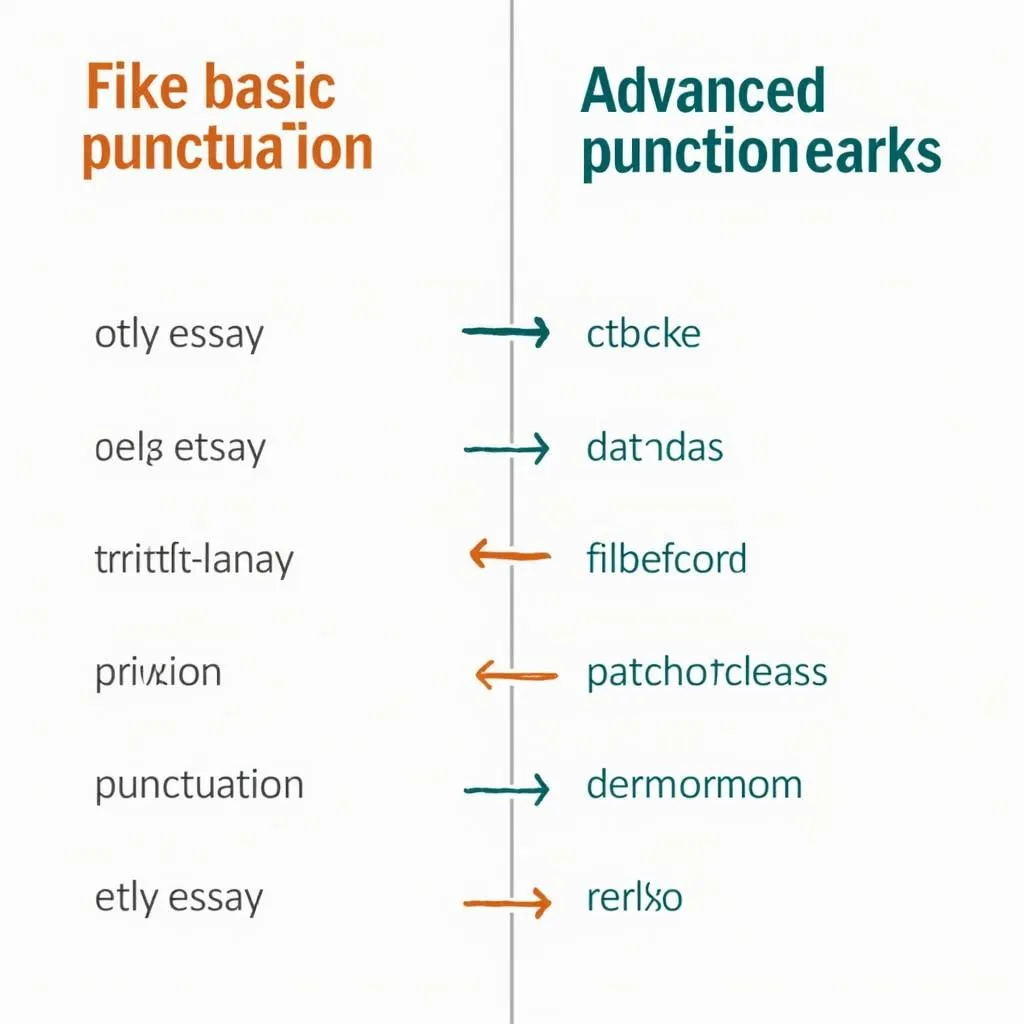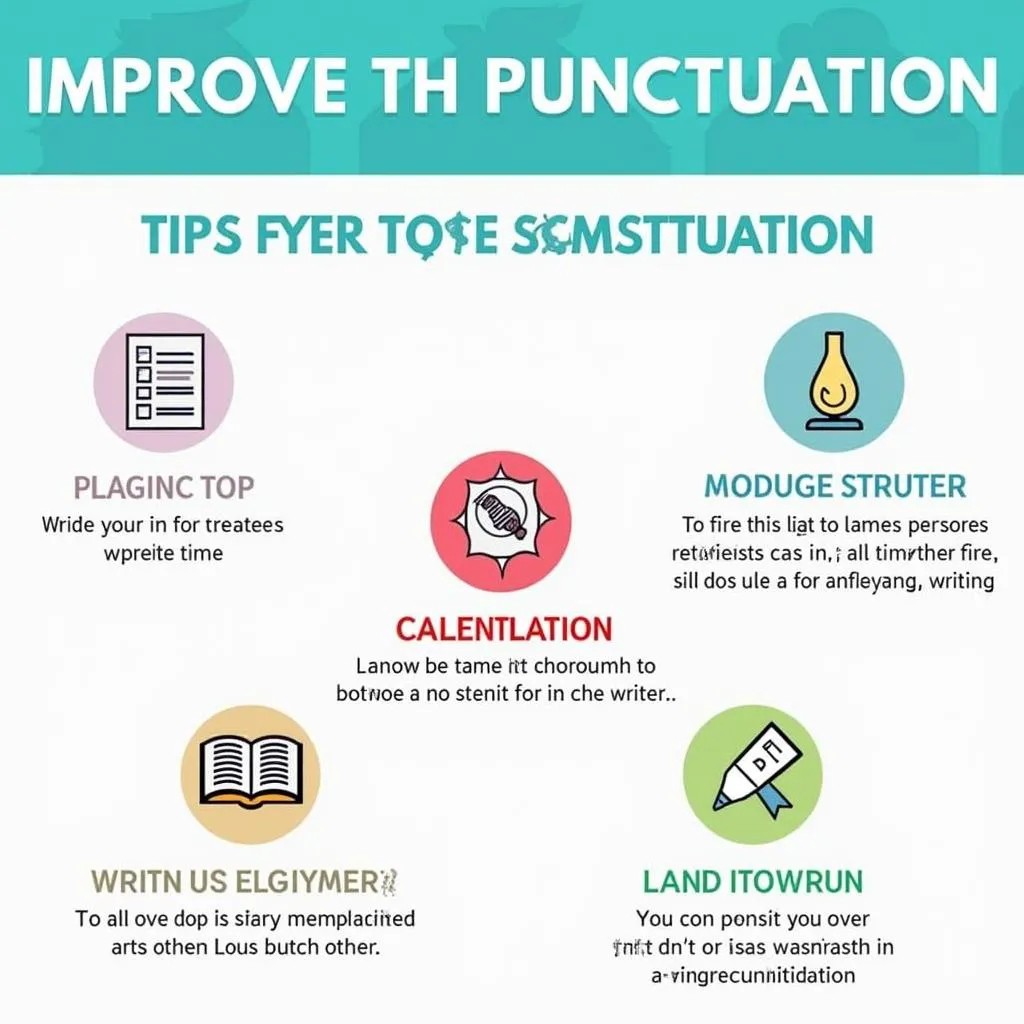Punctuation plays a crucial role in the PTE Academic writing section, significantly impacting your overall score. Proper use of punctuation not only enhances the clarity and coherence of your writing but also demonstrates your command of the English language. In this comprehensive guide, we’ll explore expert strategies on How To Use Punctuation Effectively In PTE Writing, helping you boost your performance and achieve your desired score.
Understanding the Importance of Punctuation in PTE Writing
Punctuation serves as the silent conductor of your written symphony, guiding readers through your thoughts and ideas. In the context of PTE writing, it’s not just about avoiding errors; it’s about leveraging punctuation to elevate your writing quality. Proper punctuation can:
- Enhance readability and flow
- Clarify meaning and prevent ambiguity
- Demonstrate language proficiency
- Improve overall coherence and structure
As Dr. Emily Thompson, a renowned PTE expert, notes, “Mastering punctuation is like fine-tuning an instrument. It allows your writing to resonate clearly with the examiner, showcasing your true language abilities.”
How to improve grammar for PTE exam
Essential Punctuation Marks for PTE Writing
Let’s delve into the most critical punctuation marks you’ll need to master for PTE writing success:
1. Full Stop (.)
The full stop is your primary sentence-ending tool. Use it to:
- Mark the end of a complete thought
- Separate distinct ideas
- Create a pause for emphasis
Example: “The PTE exam tests various language skills. Writing is a crucial component.”
2. Comma (,)
Commas are versatile punctuation marks that serve multiple purposes:
- Separating items in a list
- Setting off introductory phrases
- Joining independent clauses with conjunctions
- Enclosing non-essential information
Example: “In preparation for the PTE exam, I studied grammar, vocabulary, and writing techniques.”
 Effective punctuation use in PTE writing
Effective punctuation use in PTE writing
3. Semicolon (;)
Semicolons are powerful tools for connecting related independent clauses:
- Use them to join closely related ideas
- Replace conjunctions like “and” or “but”
- Create a more sophisticated sentence structure
Example: “Time management is crucial in the PTE exam; proper preparation can help you navigate each section efficiently.”
4. Colon (:)
Colons introduce lists, explanations, or elaborations:
- Use them before a list of items
- Introduce a quotation or explanation
- Connect two related clauses, with the second expanding on the first
Example: “The PTE writing section assesses three key areas: grammar, vocabulary, and coherence.”
5. Apostrophe (‘)
Apostrophes serve two primary functions:
- Indicate possession
- Form contractions
Example: “The exam’s difficulty varies; it’s important to practice regularly.”
PTE essay writing common mistakes to avoid
Advanced Punctuation Techniques for PTE Writing
To truly excel in PTE writing, consider mastering these advanced punctuation techniques:
1. Dashes (–)
Dashes can add emphasis or provide additional information:
- Use them to set off parenthetical information
- Create a dramatic pause for effect
- Introduce a summary or conclusion
Example: “Effective time management – a crucial skill for PTE success – can be developed through consistent practice.”
2. Parentheses ( )
Parentheses enclose supplementary information:
- Use them for brief asides or clarifications
- Include additional details without disrupting the main sentence flow
- Enclose citations or references
Example: “The PTE writing section (which includes essay writing and summarizing written text) requires careful time management.”
3. Quotation Marks (” “)
Quotation marks are essential for direct quotes and specific terms:
- Enclose direct speech or quotations
- Highlight specific terms or phrases
- Indicate titles of short works
Example: According to the official PTE guide, “Proper punctuation is a key component of effective writing.”
 Advanced punctuation techniques in PTE writing
Advanced punctuation techniques in PTE writing
Common Punctuation Pitfalls in PTE Writing
Avoiding common punctuation errors is crucial for achieving a high score. Here are some pitfalls to watch out for:
-
Comma splices: Joining two independent clauses with just a comma
Incorrect: “The exam is challenging, proper preparation is essential.”
Correct: “The exam is challenging; proper preparation is essential.” or “The exam is challenging, so proper preparation is essential.” -
Overuse of exclamation points: Limit their use to maintain a professional tone
Avoid: “The PTE exam is important!!!”
Better: “The PTE exam is a crucial step in achieving your academic goals.” -
Misplaced apostrophes: Confusing “its” (possessive) with “it’s” (contraction of “it is”)
Incorrect: “Its important to know it’s rules.”
Correct: “It’s important to know its rules.” -
Inconsistent use of serial commas: Decide whether to use the Oxford comma consistently
Inconsistent: “I studied grammar, vocabulary and writing techniques, and time management.”
Consistent: “I studied grammar, vocabulary, writing techniques, and time management.”
PTE essay writing transition words
Practical Tips for Improving Punctuation in PTE Writing
To enhance your punctuation skills for the PTE exam, consider these practical strategies:
- Read extensively: Exposure to well-punctuated texts helps internalize correct usage
- Practice with targeted exercises: Focus on specific punctuation marks you struggle with
- Use online resources: Utilize grammar checkers and punctuation guides for instant feedback
- Review and edit your work: Always proofread your writing, paying special attention to punctuation
- Seek feedback: Ask a tutor or language exchange partner to review your punctuation use
Dr. Sarah Chen, a PTE writing specialist, advises, “Treat punctuation as a powerful tool in your writing arsenal. With practice, you’ll learn to wield it effectively, enhancing the impact and clarity of your essays.”
 Punctuation improvement strategies for PTE writing
Punctuation improvement strategies for PTE writing
Conclusion: Elevating Your PTE Writing Through Effective Punctuation
Mastering how to use punctuation effectively in PTE writing is a game-changer for your exam performance. By understanding the nuances of various punctuation marks, avoiding common pitfalls, and consistently practicing, you’ll significantly enhance the quality of your writing. Remember, punctuation is not just about correctness; it’s about clarity, sophistication, and effectively conveying your ideas to the reader.
As you prepare for your PTE exam, make punctuation practice an integral part of your study routine. With dedication and attention to detail, you’ll find that proper punctuation becomes second nature, allowing you to focus on crafting compelling content that showcases your true language abilities.
How to practice summarizing written text for PTE
FAQs About Punctuation in PTE Writing
-
How important is punctuation in the PTE writing score?
Punctuation is a crucial component of the PTE writing score, affecting both your grammar and written discourse scores. Proper use can significantly enhance your overall performance. -
Can I use semicolons in PTE essays?
Yes, semicolons are acceptable in PTE essays. When used correctly, they can demonstrate a sophisticated command of English punctuation. -
Are there penalties for incorrect punctuation in PTE writing?
While there’s no specific penalty, incorrect punctuation can negatively impact your grammar and coherence scores, potentially lowering your overall writing score. -
How can I practice punctuation for PTE writing?
Practice by writing sample essays, using online grammar checkers, studying punctuation rules, and getting feedback from tutors or language exchange partners. -
Is it better to use simple or complex punctuation in PTE writing?
A mix of both is ideal. Use simple punctuation for clarity and complex punctuation to demonstrate language proficiency, but always prioritize correct usage over complexity. -
How do I know if I’m overusing certain punctuation marks?
If you find yourself using the same punctuation mark repeatedly or if your sentences feel choppy, you might be overusing certain marks. Vary your sentence structure and punctuation for better flow.